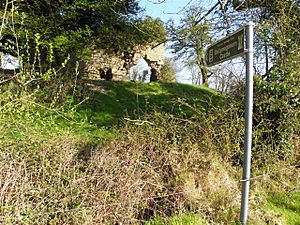Feidhlimidh Mág Samhradháin facts for kids
Feidhlimidh Mág Samhradháin (also known as Felim or Phelim McGovern) was an important Irish leader. He was the head of the McGovern family, a powerful group of people. He was also the Baron or Lord of a region called Tullyhaw in County Cavan, Ireland. He led his people from before 1611 until he passed away on January 20, 1622.
Contents
Early Life and Royal Pardons
Feidhlimidh Mág Samhradháin first appears in official records in 1586. On January 19, 1586, Queen Elizabeth I of England gave him a special pardon. This pardon was for fighting against the Queen's army. He was known as Phelim m'Brien m'Thomas Magawran, of Colleaghe at that time.
Later, on April 30, 1605, King James VI and I also gave him a pardon. This was again for fighting against the King's forces. He was called Phelim McGaran of Tolaghagh in this record.
Coologe Castle: An Ancient Home
Mág Samhradháin's family once lived in a castle in a place called Coologe. This area is now part of Templeport parish in County Cavan. Today, you can find an old earthen fort near Coologe Lough. This is likely where the castle once stood.
A very old poem from about 1290 A.D. describes what Coologe Castle looked like. It was a strong and sturdy castle. Its inside walls were made of white hazel-wood and covered with beautiful satin and tapestries. Weapons like blued-iron spears and javelins hung on racks. The castle door was decorated with gold. Outside, there was a fence bright with berries.
Inside the great hall, there were poets and musicians playing harps. A hundred warriors and hounds, held by gold chains, were also present. Guests drank wine from golden cups decorated with jewels.
However, this castle was burned down on May 3, 1298. This happened during an attack by the O'Connor clan. The old records, called the Annals of Connacht, say that Brian Bregach Mag Samradain, the leader of Tullyhaw, was killed during this attack. He was known as a very generous and brave man.
Around the year 1400, the main leader's castle moved to Ballymagauran. Coologe Castle was then given to the Tánaiste of the clan. The Tánaiste was the person chosen to be the next leader. Feidhlimidh held this important role in 1586.
Becoming a Lord
After his brother, Tomas Óg Mág Samhradháin, passed away sometime after 1586, Feidhlimidh became the new head of the Mág Samhradháin family. He moved from his home in Coologe to the main leader's residence in Ballymagauran.
Around 1602, a poet named Aonghus Ruadh na nAor Ó Dálaigh was hired by a powerful English official. This official was Charles Blount, 8th Baron Mountjoy, the Lord Deputy of Ireland. The poet's job was to travel among the Irish lords and write poems that made fun of them. This was meant to cause arguments among the Irish leaders. Many Irish lords could no longer afford to have a poet in their homes, so O'Daly was happy to have a job. However, he later paid a high price for his rude poems and was killed.
The Ulster Plantation and Land Grants
The Plantation of Ulster was a big plan by the English Crown to settle new people in Ireland. As part of this plan, King James VI and I gave Feidhlimidh a special grant on April 29, 1611. This grant officially gave him control over several modern-day areas. These included Ballymagauran, Ballymagirril, Boley, Templeport, Camagh, Derrycassan, Gortaclogher, Gortnaleck, Killymoriarty, Killywillin, Porturlan and Sruhagh.
It is likely that the Mág Samhradháin family had owned these lands for hundreds of years before this. The grant was probably a "Surrender and Regrant." This was a way for the English Crown to confirm existing ownership under English law.
Building Ballymagauran Castle
As part of the Ulster Plantation grant, Feidhlimidh had to build a new castle in Ballymagauran. In the autumn of 1611, an official named George Carew, 1st Earl of Totnes visited the area. He noted that "Magauran had his own land given him on this division."
By 1613, Feidhlimidh Mág Samhradháin had started building his new castle. Sir Josias Bodley reported on February 6, 1613, that Magauran was building a strong English-style house. It was made of lime and stone, 40 feet long and 20 feet wide. It was not yet finished, but he planned to continue building it. There was also a trench and earth wall around it, which could be made very strong.
By 1619, a survey called Pynnar's Survey of Land Holders confirmed that Mág Samhradháin had successfully built a castle on his lands.
Family and Passing
Feidhlimidh Mág Samhradháin had at least two sons: Brian Magauran and Giolla na Naomh Magauran.
An official record from King Charles I of England, made on October 4, 1626, stated that Feidhlimidh Magawrane passed away on January 20, 1622. His lands then went to his son Brian, who became the next head of the family. Brian was thirty years old (born in 1592) and married to Mary O'Brien. Local stories say that Feidhlimidh is buried on Inch Island in Templeport Lough.
A survey taken in Ballymagauran in August 1622 described Brian Magauran's property. It said he had 1,000 acres with an earth wall and a stone house inside. The house had a thatched roof, chimneys, and part of it had an upper floor.
The castle that Mág Samhradháin built after 1611 was attacked and destroyed. This happened in 1649 by Oliver Cromwell's army. A map from 1659, called Sir William Petty's Down Survey, shows the castle in the area of Dromkirke. It was marked as a "Stone house in repair" at that time.


